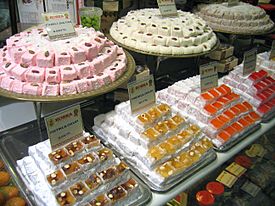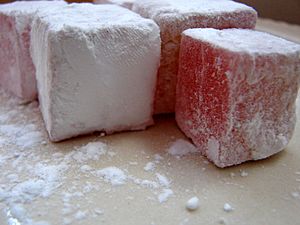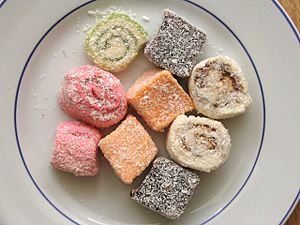Turkish delight facts for kids

An assortment of Turkish delight on display in Istanbul
|
|
| Alternative names | Lokum |
|---|---|
| Type | Confection |
| Place of origin | Ottoman Empire (Turkey), or Arab people or Safavid Empire (Iran/Persia) |
| Serving temperature | Room temperature |
| Main ingredients | Starch, sugar |
| Variations | Multiple |
Turkish delight or lokum is a sweet, jelly-like candy made from starch and sugar. It's a popular treat that comes in many flavors and often has nuts inside.
This chewy candy is usually cut into small cubes. These cubes are then dusted with icing sugar, shredded coconut, or a powder called cream of tartar. This dusting stops the pieces from sticking together.
Some popular flavors include rosewater, lemon, cinnamon, and mint. You might also find it with chopped dates, pistachios, hazelnuts, or walnuts mixed in.
Turkish delight has been made in Turkey and Iran (Persia) since at least the late 1700s.
Contents
History of Turkish Delight

The exact start of Turkish delight is not fully known. However, the Turkish word lokum comes from the Arabic word al-lukum. In the Arab world, this sweet is called rāḥat al-ḥulqūm. This means 'throat comfort'.
A company called Hacı Bekir says that Bekir Efendi started his candy shop in Constantinople (now Istanbul) in 1777. He came from Kastamonu. He made many kinds of candies, including a special lokum using starch and sugar. His family business still runs today, five generations later.
However, some historians, like Tim Richardson, question if Hacı Bekir truly invented Turkish delight. They say that similar recipes using starch and sugar existed in Arab and Persian cultures centuries before Bekir. The Oxford Companion to Food also notes that there is no strong proof that Bekir was the inventor.
Turkish delight is often sold in cool hexagonal boxes.
What's in a Name?
The Turkish names lokma and lokum come from the Arabic word luqma(t). This word means 'morsel' or 'mouthful'. Another old Ottoman Turkish name was rahat-ul hulküm. This Arabic phrase, rāḥat al-hulqūm, means 'comfort of the throat'. This is still its name in formal Arabic today.
In different countries, Turkish delight has many names:
- In Libya, Saudi Arabia, Algeria, and Tunisia, it's called ḥalqūm.
- In Kuwait, it's kabdat alfaras.
- In Egypt, it's malban or ʕagameyya.
- In Lebanon and Syria, it's simply rāḥa.
- In Greece, it's loukoumi and is sometimes called Greek Delight.
- In Cyprus, it's called Cyprus Delight and has a special protected status.
- In Armenian, it's lokhum.
- In Bosnia and Herzegovina and Israel, it's rahat lokum.
- In Serbo-Croatian, it's ratluk.
- In Persian, it's rāhat-ol-holqum.
- In the Indian subcontinent, a similar sweet is called Karachi halwa or Bombay halwa.
In English, it was once also known as Lumps of Delight.
Turkish Delight Around the World
Europe
Bulgaria
In Bulgaria, Turkish delight is known as lokum. It is quite popular there. Bulgaria makes its own lokum, which can be plain or flavored with rose petals, white walnuts, or "endreshe".
Greece
In Greece, loukoumi (Turkish delight) has been a very popular sweet since the 1800s. It's famously made in cities like Patras and on the island of Syros. Loukoumi is often served with coffee instead of biscuits. Besides rosewater and bergamot, mastic-flavored loukoumi is also very popular.
Romania and Moldova
The Romanian word for this sweet is rahat. This is a shorter version of the Arabic rahat ul-holkum. In Romania, rahat is eaten on its own or added to many Romanian cakes. These cakes include cornulețe, cozonac, or salam de biscuiţi.
Albania and Former Yugoslavia
In countries that were once part of the Ottoman Empire in the Balkans, like Serbia, Bosnia and Herzegovina, Montenegro, North Macedonia, Kosovo, and Albania, Turkish delight is known as rahat-lokum, ratluk, or lokum/llokum. It is still popular today and often eaten with coffee. Rose and walnut are the most common flavors.
Ireland, United Kingdom, and Commonwealth Countries
Fry's Turkish Delight is a popular candy bar sold by Cadbury in the United Kingdom, Ireland, Australia, South Africa, Canada, and New Zealand. It has rosewater-flavored Turkish delight covered in milk chocolate. An Armenian immigrant named Hadji Bey started a company in Ireland in 1902 to make Turkish delight for these markets.
North America
In the Greater Los Angeles area, the Nory Candy company has been making Turkish Delights since 1964. They create many fruit and unique flavors, including rose and licorice. They also make varieties with nuts like almonds, pistachios, and walnuts.
In 1930, two Armenian immigrants started Liberty Orchards in Cashmere, Washington. They began making Aplets (apple and walnut Turkish delight) and Cotlets (apricot and walnut Turkish delight). Later, they added other fruit flavors like strawberry, raspberry, and pineapple. Even though these candies have American-style names, their packaging describes them as "Locoum".
In Canada, the Big Turk chocolate bar by Nestlé has dark magenta Turkish Delight covered in milk chocolate.
Brazil
In Brazil, this sweet is known as Manjar Turco (Turkish Delight), Delícia Turca (Turkish Delight), Bala de Goma Síria (Syrian Gummy Candy), or Bala de Goma Árabe (Arab Gummy Candy). It came to Latin America with people from the Middle East.
Philippines
Turkish delight arrived in the Philippines through trade, likely in the 1800s or 1900s. It became more popular in the 1980s and 1990s. The Filipino version is called chewy gulaman. Gulaman means Filipino jelly. Traditionally, chewy gulaman is made from sea plants found in the Philippines. Once it's a chewy jelly, it's covered with local starch or coconut shavings to stop it from sticking. Today, sugar is often used as a covering instead.
India and Pakistan
In Karachi, which is now in Pakistan, a sweet called "Karachi halwa" became very popular. It was made with corn flour and ghee. It is said that Chandu Halwai developed it. After the partition in 1947, this confectioner moved to Bombay (now Mumbai). Some candy makers then called it "Bombay Halwa" to avoid its connection to a Pakistani city.
In 1896, a confectioner named Giridhar Mavji tried using wheat flour instead of starch. This led to the invention of "Mahim halwa," which comes in flat sheets.
Special Protected Status
Even though Turkish delight is popular worldwide, only one type has a special protected status. This is Λουκούμι Γεροσκήπου (Loukoumi Geroskipou). It is a Turkish delight made in Yeroskipou, Cyprus. This means it has a protected geographical indication (PGI), like a special label that says it comes from a specific place.
Related Products

Turkish delight was an early inspiration for the jelly bean. It gave the idea for the jelly bean's chewy inside.
Some fancy perfumes are even based on the smell of Turkish Delight. Examples include "Loukhoum" by Ava Luxe and "Rahät Loukoum" by Serge Lutens.
See also
 In Spanish: Delicia turca (dulce) para niños
In Spanish: Delicia turca (dulce) para niños






